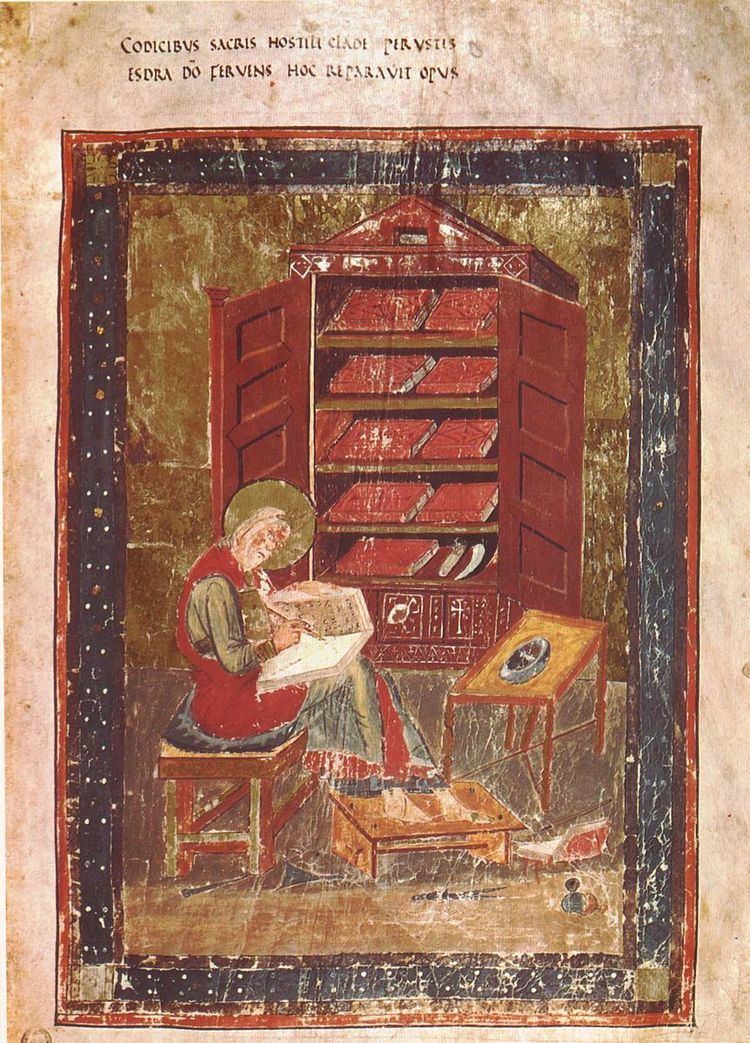 | ||
The Codex Amiatinus, designated by siglum A, is the earliest surviving manuscript of the nearly complete Bible in the Latin Vulgate version, and is considered to be the most accurate copy of St. Jerome's text. It is missing the Book of Baruch. It was produced in the Anglo-Saxon kingdom of Northumbria as a gift for the Pope, and dates to the start of the 8th century. The Codex is also a fine specimen of medieval calligraphy, and is now kept at Florence in the Biblioteca Medicea Laurenziana (Amiatino 1).
Contents
It is named after the location in which it was found in modern times, Mount Amiata in Tuscany, at the Abbazia di San Salvatore.
Description
The symbol for it is written am or A (Wordsworth). It is preserved in an immense tome, measuring 19 1⁄4 inches high, 13 3⁄8 inches in breadth, and 7 inches thick, and weighs over 75 pounds — so impressive, as Hort says, as to fill the beholder with a feeling akin to awe.
It contains Epistula Hieronymi ad Damasum, Prolegomena to the four Gospels.
The Codex Amiatinus qualifies as an illuminated manuscript as it has some decoration including two full-page miniatures, but these show little sign of the usual insular style of Northumbrian art and are clearly copied from Late Antique originals. It contains 1040 leaves of strong, smooth vellum, fresh-looking today despite their great antiquity, arranged in quires of four sheets, or quaternions. It is written in uncial characters, large, clear, regular, and beautiful, two columns to a page, and 43 or 44 lines to a column. A little space is often left between words, but the writing is in general continuous. The text is divided into sections, which in the Gospels correspond closely to the Ammonian Sections. There are no marks of punctuation, but the skilled reader was guided into the sense by stichometric, or verse-like, arrangement into cola and commata, which correspond roughly to the principal and dependent clauses of a sentence. From this manner of writing the script is believed to have been modeled upon the Codex Grandior of Cassiodorus, but it may go back, perhaps, even to St. Jerome.
History
Originally three copies of the Bible were commissioned by Ceolfrid in 692. This date has been established as the double monastery of Wearmouth-Jarrow secured a grant of additional land to raise the 2000 head of cattle needed to produce the vellum. Bede was most likely involved in the compilation. Ceolfrid accompanied one copy intended as a gift to Pope Gregory II, but he died en route to Rome. The book later appears in the 9th century in Abbey of the Saviour, Monte Amiata in Tuscany (hence the description "Amiatinus"), where it remained until 1786 when it passed to the Laurentian Library in Florence. The dedication page had been altered and the librarian Angelo Maria Bandini suggested that the author was Servandus, a follower of St. Benedict, and was produced at Monte Cassino around the 540s. This claim was accepted for the next hundred years, establishing it as the oldest copy of the Vulgate, but scholars in Germany noted the similarity to 9th-century texts. In 1888 Giovanni Battista de Rossi established that the Codex was related to the Bibles mentioned by Bede. This also established that Amiatinus was related to the Greenleaf Bible fragment in the British Library. Although de Rossi's attribution removed 150 years from the age of the Codex, it remained the oldest version of the Vulgate.
As the primary source of the Vulgate, the manuscript was of particular importance to the Catholics during the Counter-Reformation. Protestant translations derived from the original language of the Scriptures, but the supposedly sixth-century Latin text of the Amiatinus was earlier than any then-known Hebrew manuscript, making it a "major piece of propaganda in the battle for textual precedence". In 1587 Pope Sixtus V demanded the book be sent to Rome where it was used as the principal source for a new papal edition of the Bible, the Vulgata Sixtina.
